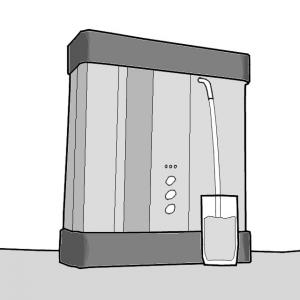Advanced point-of-use filter systems of various designs, costs and effectiveness are today readily available all over the world. While these systems are quite reliable, they are high-tech and rather expensive in investment and operation and maintenance. It is important that the chosen technology is adapted to the level of water contamination and that the user is correctly instructed for installation, operation and maintenance. The most common technologies applied in these filters, either alone or in combination, are sedimentation, activated carbon, membranes, ceramics, and Ultra Violet radiation. They are applicable in households, schools, small communities or hospitals.
| In | Out |
|---|---|
Drinking Water |
Tap water is very often not safe enough to drink, due to microbial and chemical contaminants, which endanger human health.
Today, advanced point-of-use filter systems of various designs, costs and effectiveness are readily available all over the world, and several small-scale treatment possibilities have been developed. While these systems are quite reliable, they are high-tech and rather expensive in investment and operation and maintenance for the provider or the household itself. The most common technologies applied in these filters, either alone or in combination, are sedimentation, activated carbon, membranes, ceramics, and Ultra Violet radiation. The aim for all of these technologies is the same: to make sure that people all around world have access to save drinking water.
Reverse osmosis filter
Reverse osmosis has become the water purification method of choice for drinking water in many households and bottling plants (see also centralised reverse osmosis) throughout the world. It is a very efficient method to purify water from even very small molecules. There are many providers of reverse osmosis filter devices but, in general, the treatment stages are the same. It is possible to combine reversed osmosis filters with UV, infrared technology, or ozonation for disinfection (see also UV tubes and ozonation). PUREPRO filters have 4 to 6 filter stages in different combinations (PUREPRO 2012):
Stage 1 (5 Micron Sediment Filter): Removes dirt, rust and sand particles.
Stage 2 (Granular Activated Carbon Filter or Carbon Block Filter): Takes out 99% of the chlorine and organic chemicals and provides enhanced reduction of taste, odour, and colour.
Stage 3 (1 Micron Sediment Filter): Provides effective filtration to protect the membrane.
Stage 4 (Reverse Osmosis (RO) Membrane): A thin film composite (TFC) high quality membrane processes 80 gallons (300 litres) per day. It removes the following hard water contaminants that may be present in the water: lead, cooper, barium, chromium, mercury, sodium, cadmium, fluoride, nitrite, nitrate, and selenium.
Additional Filter Stages:
Stage 5 (Post Carbon Filter): Removes objectionable tastes and odours to enhance the quality of drinking water.
Stage 6a (Deionisation (DI) Filter): Produces 99.99% pure water by simply attaching this convenient deionisation filter with RO unit. A convenient post RO filtration DI unit (RO/DI unit) provides crucial supplemental filtration to remove most impurities for pure polished product water. Excellent in areas with hard water.
Stage 6c (Mineral Filter): This filter improves the qualities of clean water by adding minerals which are necessary for proper human development and health, such as calcium, magnesium, sodium, potassium and others readily found in many natural mineral waters.
Stage 6d (Ultraviolet Water Steriliser): Ultraviolet light (UV), a natural part of sunlight is widely accepted as a reliable, efficient & environmentally friendly solution for water disinfection. The UV lamp destroys 99.99% of bacteria and viruses.
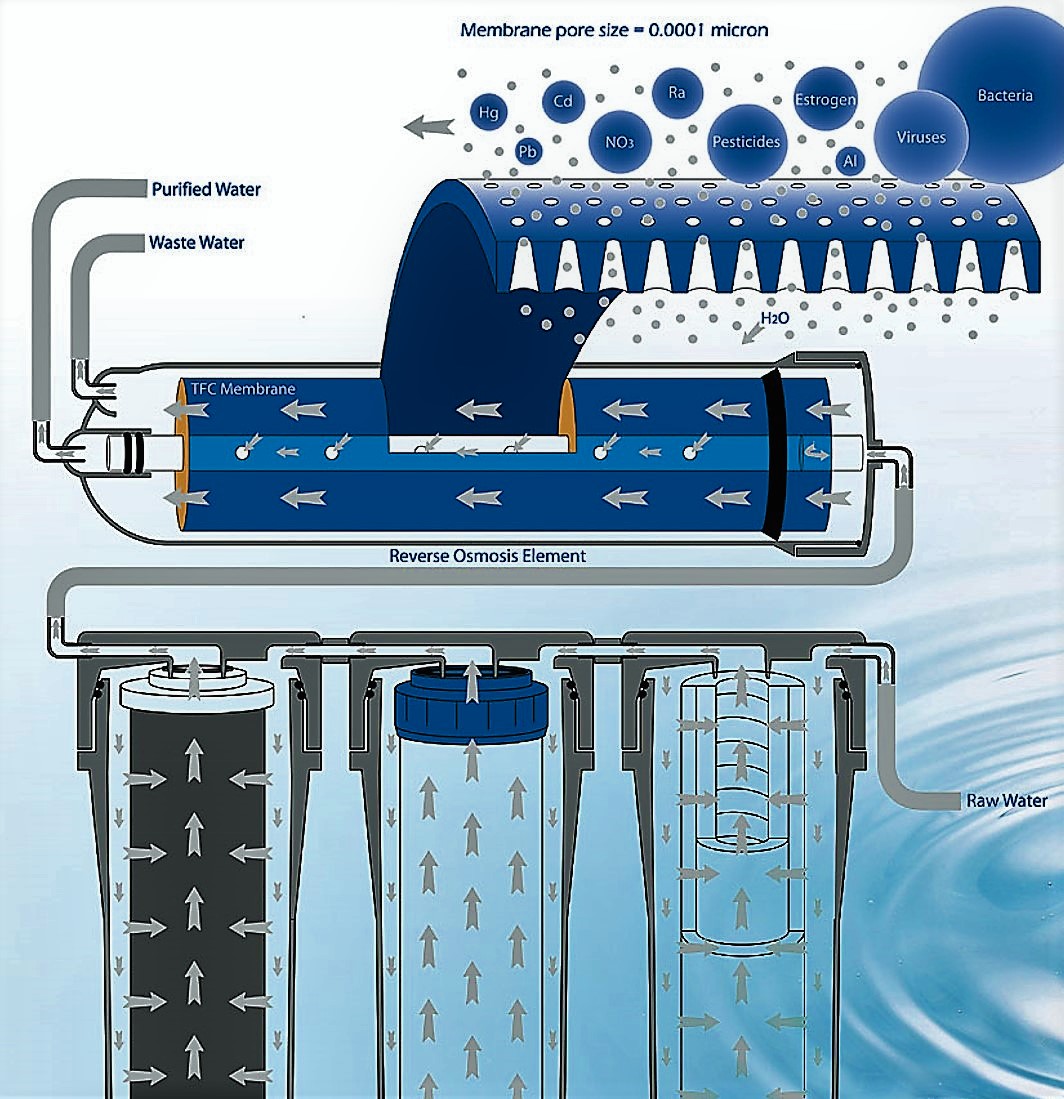
Reversed osmosis filter systems might be too expensive for some parts of the world. They also need a power supply (pump) and should not be used for water which is over 45°C. The filter system should not be frozen and an ideal water pressure should be provided. The three pre-filters should be changed every 6 months (PUREPRO 2012).
Activated carbon filters
Activated carbon filters normally have a pre-filter to remove sediments and avoid damage of the carbon unit. They are well suited to sediment and particulate removal as well as the reduction of chlorine, chlorine disinfection bi-products, a wide range of volatile organic compounds, and other contaminants responsible for bad tastes and odours. The filter system WH3, for example, is a good choice for well water, lake water, stream water, and municipal (city) water treatment applications. These filter systems are expensive (up to 200 US$ and more) and require periodic maintenance (change of filter components) (HOME WATER n.y.).
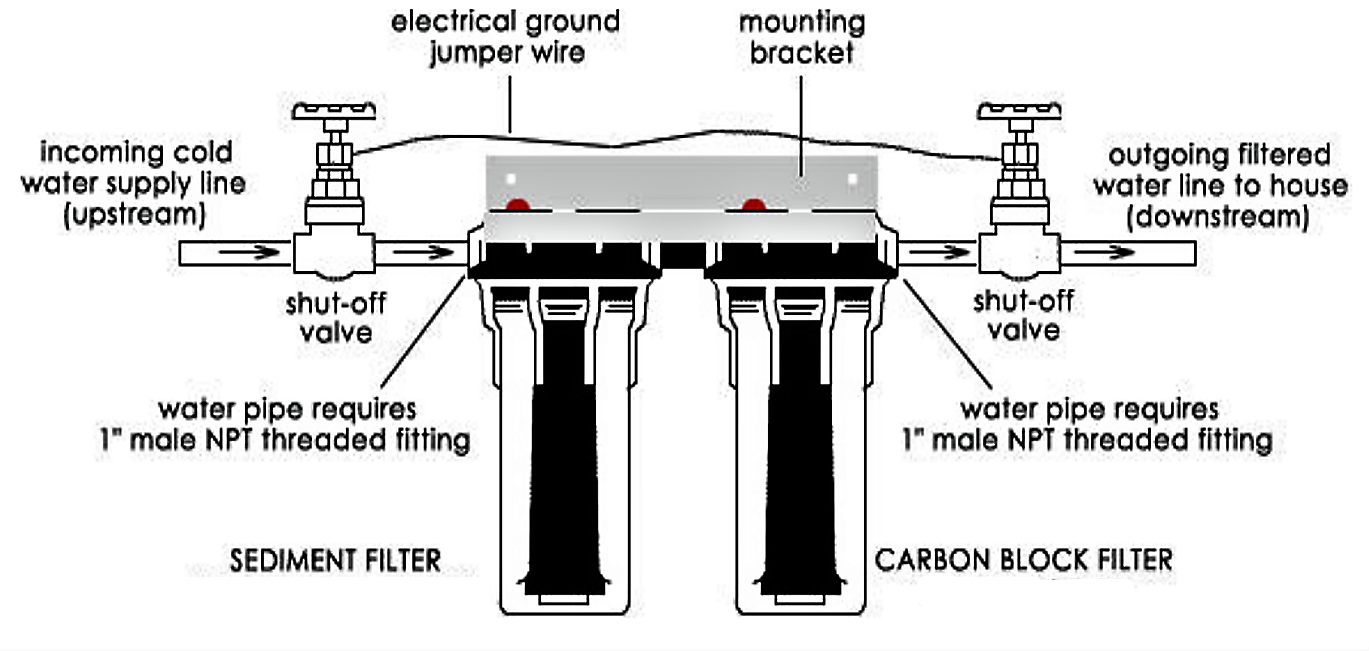
Tap filter
Tap filters are filters that can be fitted directly onto a faucet. They are easy to handle and quite effective since they remove pathogens (e.g. Cryptosporidium and Giardia), contaminants (e.g. chlorine, lead, asbestos), sediments and bad odours. The user can turn the filter on and off by switching a small handle. Most often, these filters are based on activated carbon (see also adsorption). The filter medium should be changed frequently (following providers’ requirements) to ensure its effectiveness. Costs vary between 20 and 40 US$ (depending on country and provider). The filters should not be used without assessing their performance and the water quality to treat.
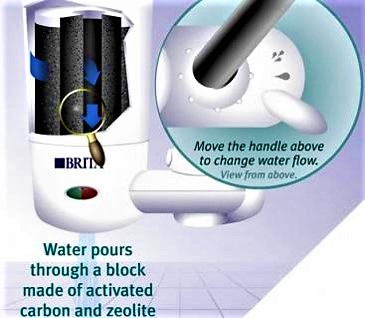
Tulip water filter
The Tulip water filter is a candle-type water filter (see also ceramic candle filter), which uses gravity siphon pressure to force water through a high-quality ceramic filter element. The innovative usage of the siphon results in a high flow rate of 4-5 litres per hour. The filter is impregnated with silver (see also colloidal silver filter) in order to increase the bacterial removal efficiency of the filter and to reduce the recontamination risk of stored filtered water. The filter must be cleaned by backwashing because sediments can lead to clogging. Ceramic filters remove pathogens effectively. Read also the manual provided by TULIPWATERFILTER (2012). The price for one filter is 29 US$.
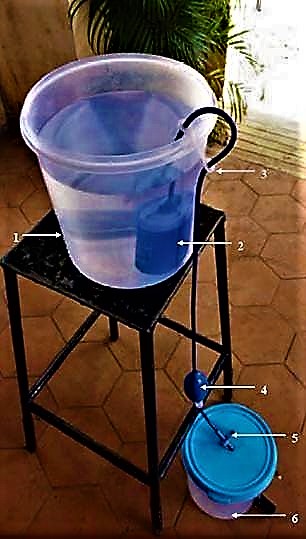
Gravity-Driven Membrane (GDM) technology
Adapted from EAWAG (2011)
Ultrafiltration is an effective technology to treat water and, in principle, can be applied on a decentralised scale. Most ultrafiltration membranes have pores that are smaller than the size of bacteria and viruses. Thus, water filtered through these membranes is microbiologically safe. In gravity-driven membrane (GDM) technology, no backflushing or cleaning is used. Pressure necessary to press water through the membranes is generated by gravity produced by differing water levels between two storage tanks. As a feed, natural water (river, spring, well or rainwater) can be used without pre- or post-treatment.
Although turbid waters can be used, a pre-treatment is required if the water is extremely turbid. GDM technology has a high potential for implementation for drinking water treatment in households or for communities. The eventual production cost of a household filter is estimated at approximately 30€. Assuming a system lifetime of several years, the running costs of the system should be affordable for poor Kenyan households. However, the initial investment costs could represent a significant barrier to adoption. Alternate financing mechanisms, including rental or leasing options, and possibly extension of microcredit loans, should be explored.
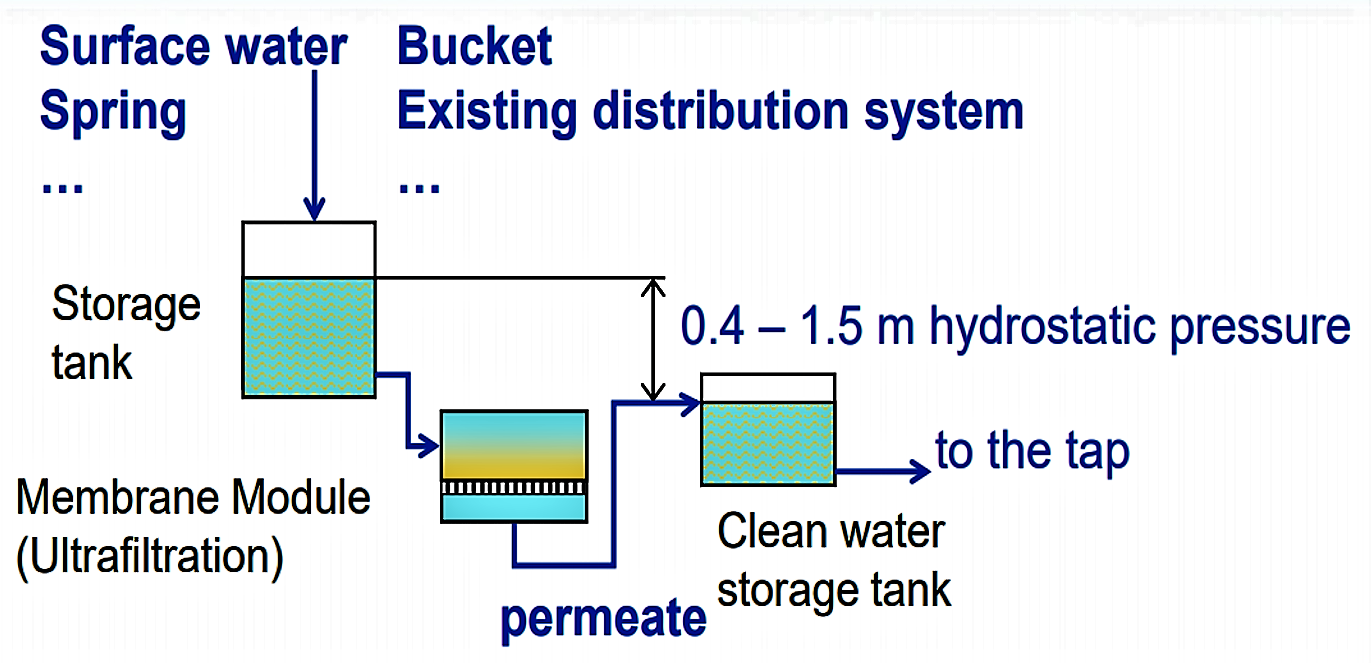

Life straw
(Adapted from VESTERGAARD FRANDSEN 2011)
The company VESTERGAARD FRANDSEN developed the concept of the Life Straw. Water filters have been shown to be the most effective interventions amongst all point-of-use water treatment methods for reducing diarrhoeal diseases. The Cochrane (2006) review demonstrates that it is not enough to treat water at the point-of-source; it must also be made safe at the point-of-consumption. LifeStraw® and Life Straw® Family are both point-of-use water filters based on membrane technology. They were developed to provide an affordable tool to purify water at home and outside.
The LifeStraw® offers easy access to clean and safe drinking water away from home. It filters at least 1000 L of contaminated water and removes waterborne bacteria very effectively. It reduces turbidity without any help of chemicals or electrical power. Depending on the source, e.g. HANLON (2012), the LifeStraw® costs around 2 US$.
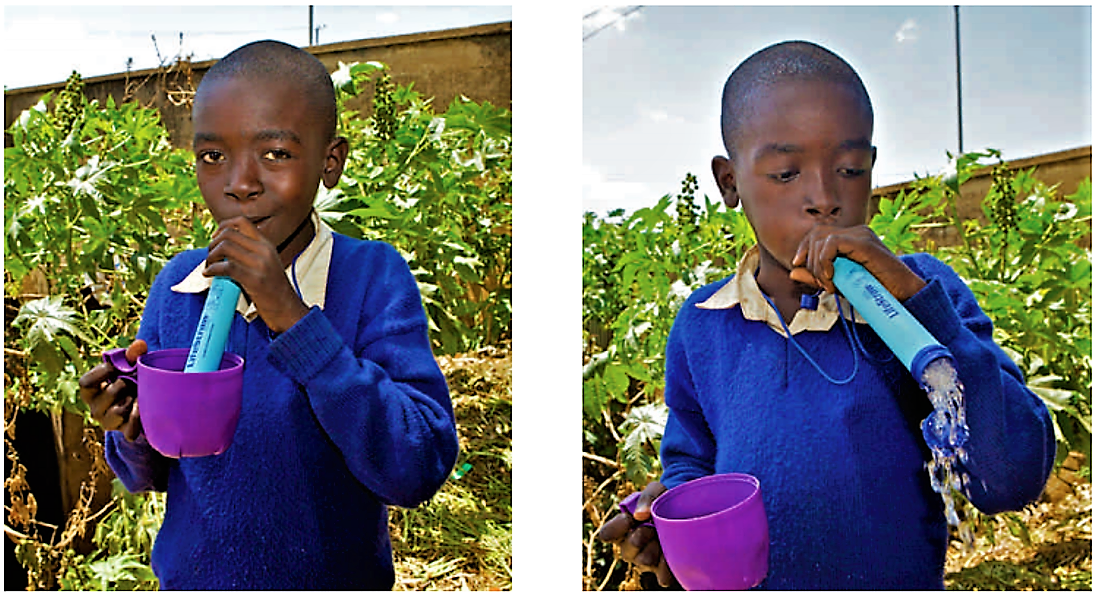
LifeStraw® Family is a point-of-use water treatment system providing instant access to clean and safe drinking water. It filters up to 18,000 litres of water; enough to supply a family of five with microbiologically clean drinking water for three years. The LifeStraw® Family ensures a high flow rate and high volume of purified water without any electrical supply or running piped water, and it is easy to clean. According IRC (2008), it costs around 20 US$.
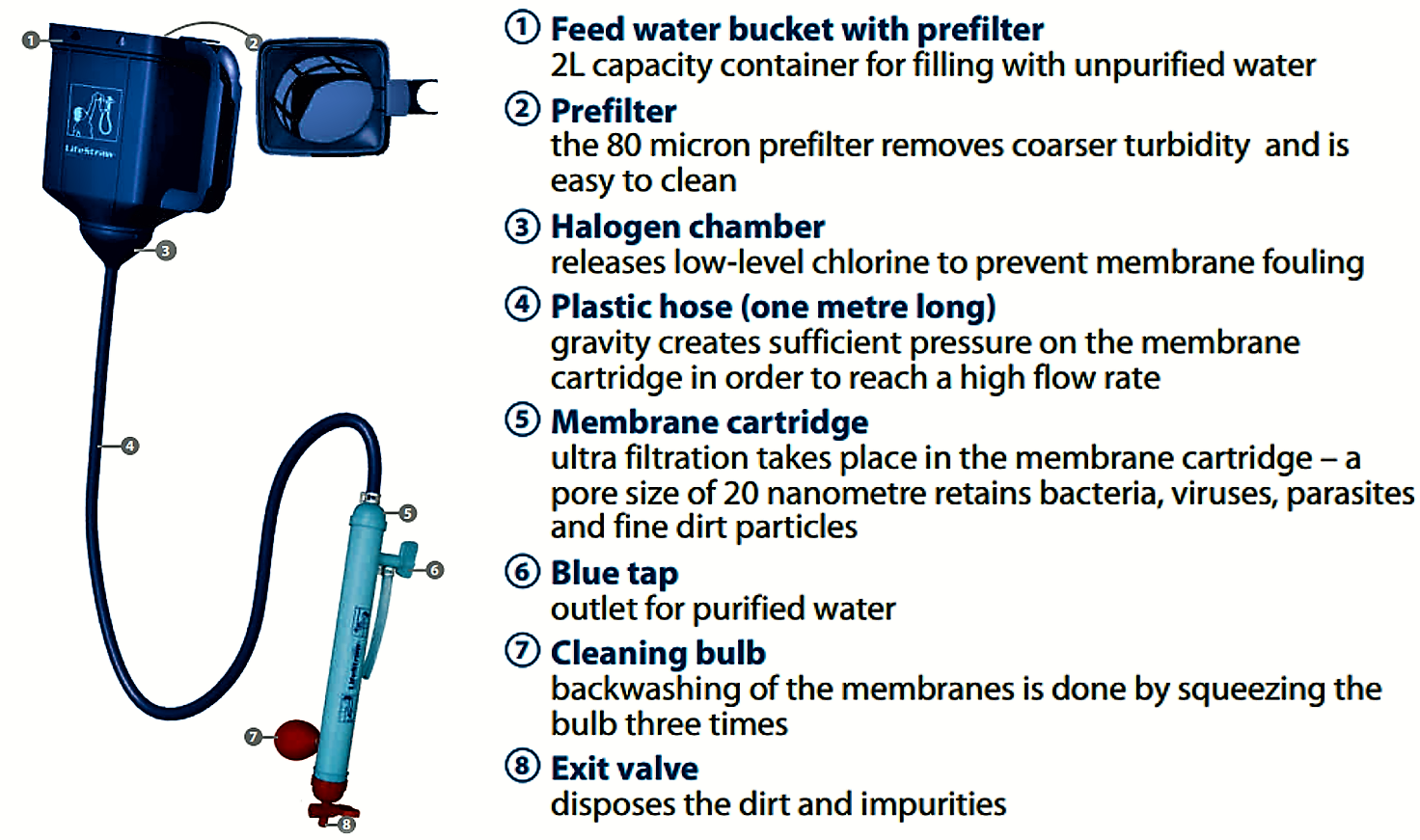
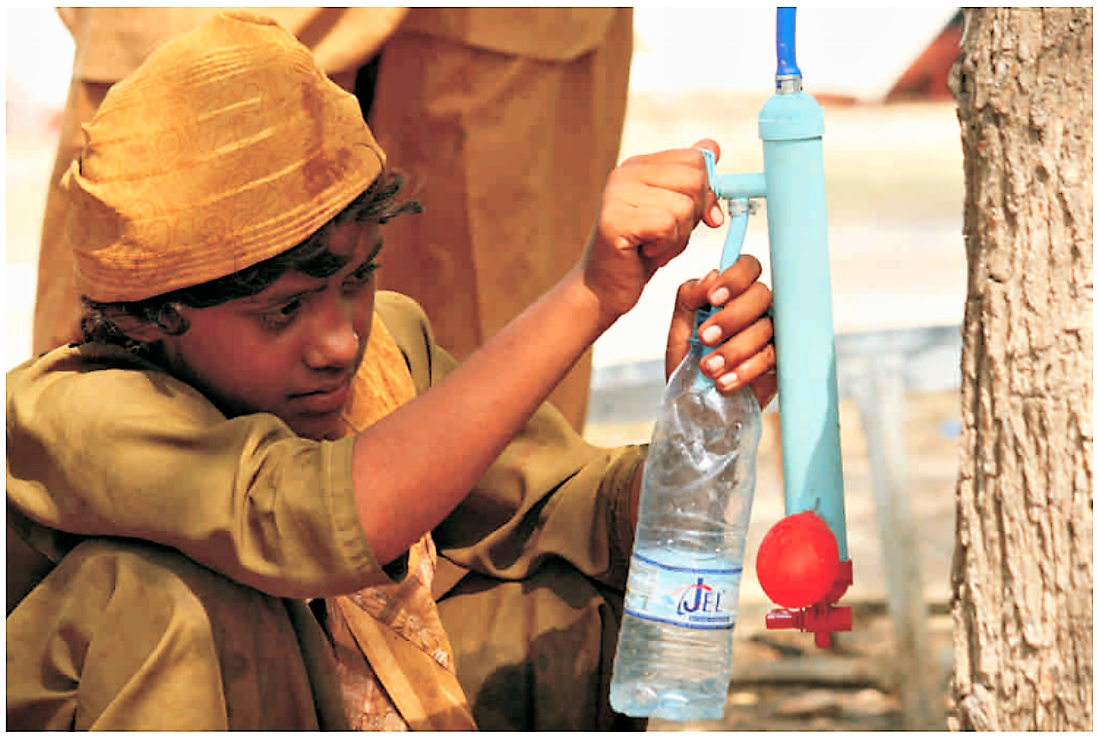
Point-of-use advanced filters can be applied in households, schools, hospitals, offices or small communities. The technique that should be implemented depends on each situation and location, and should take into account factors such as the type of contaminants in the water, the (electrical) power source available and the financial situation of users. Furthermore, it is very important that users are instructed correctly for operation and maintenance of the specific filter.
Animated Demonstration of Tap Filters
Project: Gravity-Driven Membrane (GDM) Technology
The LifeStraw Makes Dirty Water Clean
WH3 Premium Multi-Stage Whole House Filtration System Granular Activated Carbon (GAC)
Point-of-use Treatment: Vestergaard Frandsen Launches LifeStraw(R) Family
Gravity Driven Membrane Disinfection for Household Drinking Water Treatment
A short presentation about the Gravity Driven Membrane technology illustrated with pictures and graphs.
PETER-VARBANETS, M. JOHNSTON, R. MEIERHOFER, R. KAGE, F. MUELLER, S. PRONK, W. (2011): Gravity Driven Membrane Disinfection for Household Drinking Water Treatment. Duebendorf: Swiss Federal Institute of Aquatic Science and Technology (EAWAG) URL [Accessed: 20.05.2019]PurePro Drinking Water System
User’s Manual. LUX-106R-P
In a water purification system, the goal is not to dilute the salt solution, but to separate the pure water from the salt and other contaminants. When the natural osmotic flow is reversed, water from the salt solution is forced to pass through the membrane in the opposite direction by application of pressure-thus the term REVERSE OSMOSIS. Through this process, it is possible to produce pure water by screening out the salts and other contaminants.
PUREPRO (2012): User’s Manual. LUX-106R-P. Illinois: PurePro USA Corporation URL [Accessed: 17.04.2012]Why is Reverse Osmosis Better
Tulip Water Filter User Manual
This user manual gives you a quick overview about the use of the tulip water filter.
TULIPWATERFILTER (2010): Tulip Water Filter User Manual. Ras Al Khaimah, United Arab Emirates: Tulip FZE URL [Accessed: 20.05.2019]Life Straw
In this brochure, the Life Straw concept is described as well as the reasons of it development and how this filters have to be operated and maintained.
VESTERGAARD FRANDSEN (2011): Life Straw. Lausanne: Vestergaard Frandsen URL [Accessed: 20.05.2019]Review: Decentralized Systems for Potable Water and the Potential of Membrane Technology
This review focuses on decentralised systems that treat the potable water (drinking and cooking) of a single household (point-of-use systems) or a community (small-scale systems). For application in developing and transition countries, important boundary conditions for decentralised systems include low costs, ease of use, sustainability, low maintenance and independence of utilities (energy sources). Although some low-cost systems are available, their application is limited by time-consuming daily operation and maintenance. Other systems are too expensive for the poor populations of developing and transition countries and in most cases do not fulfil the system requirements described above. Point-of-use systems based on membranes are commercially available and are designed to operate on tap pressure or gravity.
PETER-VARBANETS, M. ; ZURBRÜGG, C. ; SWARTZ, C. ; PRONK, W. (2009): Review: Decentralized Systems for Potable Water and the Potential of Membrane Technology. In: Water Research: Volume 43 , 245-265. URL [Accessed: 13.05.2019]Gravity-Driven Membrane Disinfection for Household Drinking Water Treatment
Ultrafiltration (UF) has been proven to be very effective in the treatment of water for the removal of particles, colloids and microorganisms. However, household application of UF is limited due to membrane fouling which results in complex and maintenance-intensive UF systems. In gravity-driven membrane disinfection (GDMD) technology, a stable membrane flux of 4-10 L.h-1m-2 is observed during ultrafiltration without any back flushing, chemical cleaning or an external energy supply for over 24 months, while operated at relatively low pressures (40-65 cm of water column). This novel approach to operate UF systems at stable flux conditions can be considered an important breakthrough in membrane technology, as it allows development of a robust, maintenance-free, low-cost and user-friendly household water treatment system, which has a great potential for implementation.
PETER-VARBANETS, M. JOHNSTON, R. MEIERHOFER, R. KAGE, F. PRONK, W. (2011): Gravity-Driven Membrane Disinfection for Household Drinking Water Treatment. Loughborough, UK: 35th WEDC International Conference URL [Accessed: 20.05.2019]User’s Manual. LUX-106R-P
In a water purification system, the goal is not to dilute the salt solution, but to separate the pure water from the salt and other contaminants. When the natural osmotic flow is reversed, water from the salt solution is forced to pass through the membrane in the opposite direction by application of pressure-thus the term REVERSE OSMOSIS. Through this process, it is possible to produce pure water by screening out the salts and other contaminants.
PUREPRO (2012): User’s Manual. LUX-106R-P. Illinois: PurePro USA Corporation URL [Accessed: 17.04.2012]Tulip Water Filter User Manual
This user manual gives you a quick overview about the use of the tulip water filter.
TULIPWATERFILTER (2010): Tulip Water Filter User Manual. Ras Al Khaimah, United Arab Emirates: Tulip FZE URL [Accessed: 20.05.2019]Life Straw
In this brochure, the Life Straw concept is described as well as the reasons of it development and how this filters have to be operated and maintained.
VESTERGAARD FRANDSEN (2011): Life Straw. Lausanne: Vestergaard Frandsen URL [Accessed: 20.05.2019]Conservation et Traitement de l Eau a Domicile
This practical guide provides a review of different processing techniques and adequate water conservation at home and is structured around 10 key questions that should be posed before choosing a suitable solution.
DESILLE, D. (2013): Conservation et Traitement de l Eau a Domicile. Paris: Programme Solidarite Eau (PSeau) URL [Accessed: 06.06.2013]Gravity Driven Membrane Disinfection for Household Drinking Water Treatment
A short presentation about the Gravity Driven Membrane technology illustrated with pictures and graphs.
PETER-VARBANETS, M. JOHNSTON, R. MEIERHOFER, R. KAGE, F. MUELLER, S. PRONK, W. (2011): Gravity Driven Membrane Disinfection for Household Drinking Water Treatment. Duebendorf: Swiss Federal Institute of Aquatic Science and Technology (EAWAG) URL [Accessed: 20.05.2019]Gravity-Driven Membrane (GDM) technology
Read more about EAWAGs Gravity-Driven Membrane (GDM) technology project. There also downloads available.
LifeStraw water filters
Check out the life straw on the Vestergaard-Frandsen homepage and learn more about this product.


